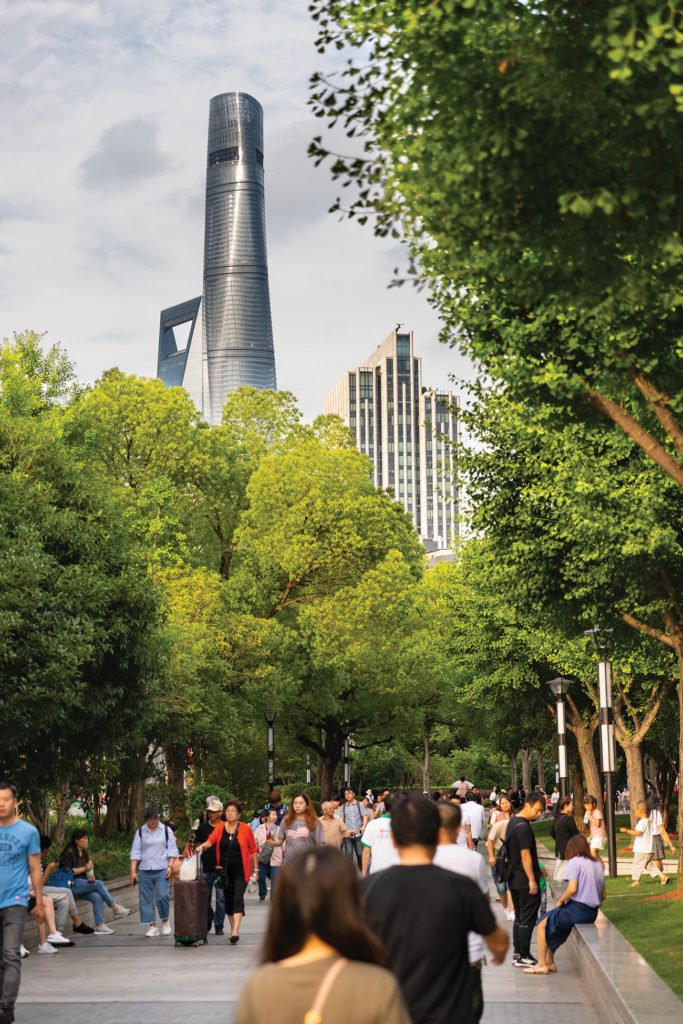Greening Asia’s City Streets: Why All Cities Should Prioritise Green Walking
September 24, 2021
Imagine walking along a city street under the cooling shade of large trees, with the sounds of birds chirping and the wind rustling the leaves; the fresh smell of the sun burning off the previous rain on the greenery; the wide footway, buildings and roadside fringed in green—you pause and contemplate sitting for a while on the conveniently located bench, and almost forget that you’re walking in a city…
Creating this type of urban walking experience in Asian cities is no accident. It can be the combination of both historic and contemporary policies, design and commitment to creating more people and walking-centred streets and integrating nature into the urban fabric. It requires an understanding that doing so can create more sustainable, resilient and liveable towns and cities, contributing to a greater quality of life for urban populations.
A TRADITION OF WALKING IN THE HEART OF ASIAN CITIES
Walkability in Asian cities was historically1 something that was brought about by necessity over millennia, with high population density and urban centres traditionally planned around markets and street-level activities2 that attract people on foot, as the epicentre of urban life and residents coming together. This created cities that were planned around walking as the main form of urban mobility across the continent. Another example is the five-foot ways or kaki lima3 that were developed in the 17th century in colonial Southeast Asian cities to provide continuous protected walkways for pedestrians in front of shophouses.

Photo by Richard Lambert.

Photo by Richard Lambert.
However, like the struggle for space along five-foot ways in Asian cities, the 20th century’s rapid urban development and a focus on creating new infrastructure and planning cities primarily for private motor vehicles led to poor pedestrian environments4. The prioritisation of policies and development towards motor vehicles led to a deterioration of walking environments resulting in unsafe, unattractive and disconnected pedestrian routes—severed and alongside congested roads. This was all despite a large proportion of Asian urban populations still relying on walking as a primary means of transport5. This lack of development for people-centred infrastructure, combined with a rise in private motor transport across Asia and more recent increases in the use of ride hailing, has led to urban populations increasingly using private means of transport.
IMPACT OF COVID-19 ON THE FUTURE OF WALKABILITY AND GREEN INFRASTRUCTURE IN ASIA
The COVID-19 pandemic has led to a further paradigm shift in the importance of providing space for walking and access to green space in the short and long term, both globally but also specifically within Asian cities. The UN-Habitat’s report on Cities and the Pandemic39 highlights how cities promoted walking as urban populations’ travel patterns changed with service reductions of public transport and private vehicle use during lockdowns; and how the pandemic has shone a light on the inequity of urban populations’ access to open green space. The Asian Development Bank’s COVID-19 and Liveable Cities in Asia and the Pacific report40 calls on cities to learn lessons from the pandemic, to revisit urban planning and focus on healthy and environmentally sustainable cities, whilst calling for medium- and long-term rethink of the need for greater investment in space for people and to support future travel patterns, with walking for short trips being a key focus.
[This is an excerpt. Subscribe to the digital edition or hardcopy to read the complete article.]
Richard Lambert is a professional and passionate urban practitioner with over 12 years of experience developing policies and delivering projects on creating sustainable and healthy urban communities, working primarily within the UK and Asia. He is currently Founder of Natural Walking Cities (https://naturalwalkingcities.com/); Associated Expert for international NGO Cities Forum (https://www.citiesforum.org/); and Director and Urban Lead for Fare City (https://farecity.org/). His extensive experience includes advising and working in partnership with national and local governments; the private sector; academic institutions; and NGOs on award-winning pedestrian and urban green space programmes; as well as providing innovative solutions for how walkable green spaces enhance urban sustainability and quality of life for urban populations.
References
1 https://think-asia.org/bitstream/handle/11540/1408/ adb-wp17-walkability-pedestrian-facilities-asian-cities. pdf?sequence=1
2 https://www.smartcitiesdive.com/ex/sustainablecitiescollective/china-s-pedestrianization- reviving-tradition-walking-healthier-cities/1089003/
3 https://www.researchgate.net/publication/283796514_Kaki_Lima_or_Five_Foot_Way_as_Contesting_Space_between_European_and_Asian_Values
4 https://www.uncrd.or.jp/content/ documents/6988Background Paper for EST Plenary Session 5-11th Regiona EST Forum.pdf
5 https://www.unescap.org/sites/default/files/The State of Asian and Pacific Cities 2015.pdf
39 https://unhabitat.org/sites/default/files/2021/03/cities_and_pandemics-towards_a_more_just_green_and_healthy_future_un-habitat_2021.pdf
40https://www.adb.org/documents/covid-19-livable-cities-asia-pacific-guidance-note
Read more Walkability stories below:



To read the complete article, get your hardcopy at our online shop/newsstands/major bookstores; subscribe to FuturArc or download the FuturArc App to read the issues.
Previously Published Commentary
Contact us at https://www.futurarc.com/contact-us for older commentaries.


